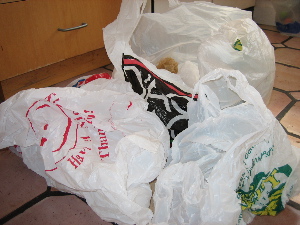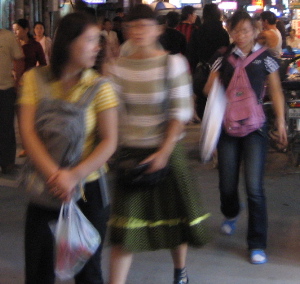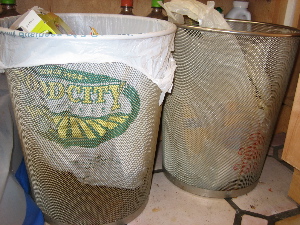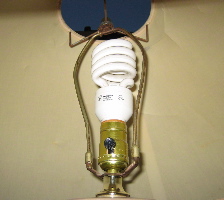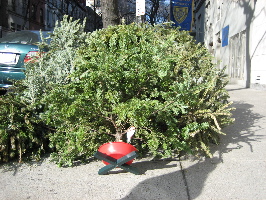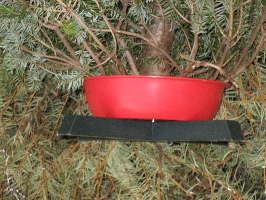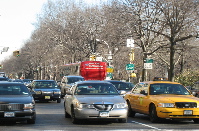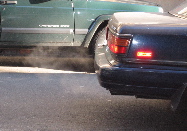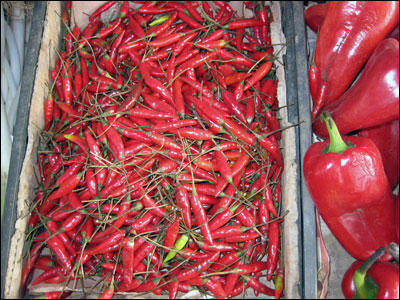
Markets are a still a big part of life in rural China and are usually the main place that people buy their groceries. The Zoiige market sells quite a few varieties of colorful peppers.
It didn’t start as a slow burn, or a tingle, or even a twinge. I had expected the hotness to build up gradually, the supposed intricate balance of heat and flavor to melt in my mouth. I had expected to douse the fire with cold beer and kick back feeling satisfied by finally eating an authentic spicy meal. Instead, the food instantly numbed my mouth, I could barely eat it, and I had immediate heartburn.
I was sitting in a huoguo, or hotpot restaurant, in Chengdu, the capital of China’s Sichuan Province. I came to Sichuan searching for spice, and knew that this was the place for it. My guidebook gave me high hopes, proclaiming Sichuan to be an authentic source for spicy food. The book even included a Chinese saying, “Shi zai Zhongguo, wei zai Sichuan,” which translates into: “China is the place for food, but Sichuan is the place for flavor.” Sichuan cuisine — or Szechuan, as it is more commonly known — is renowned for its hotness, which is something that I have always sought but was unable to find in American Chinese restaurants. Back home in the United States, I always needed to order the food “extra spicy.” I craved spice, so I came to the source.
Sichuan Province is located in the southwest of China and is about the size of France. Its unique positioning has the natural beauty of the high mountains of Tibet on one side with the Yangtze River creating the border with other neighboring provinces. The authentic Sichuan pepper originates in the Himalayan region and is sometimes called “mountain berry” in Chinese. It is a hearty small peppercorn that has medicinal anesthetic qualities.
This is contrary to the belief that the red chili peppers inside Szechuan dishes in the U.S. are real Sichuan peppers. Sichuan cooking incorporates both the Sichuan peppercorns and red chili peppers to create fiery and mouth-numbing dishes. Because Sichuan is home to 53 ethnic minorities, including Tibetans and Hui (Muslims), there is a wide range of cuisine. But spice, I find, is the universal language here. I start my journey through Sichuan in the Tibetan town of Langmusi and wind my way down to Chengdu, sampling the variations of spice along the way.
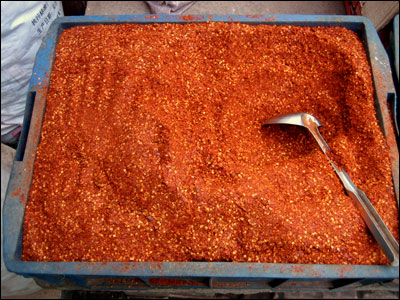
Fresh peppers are often used in Sichuan cooking but sometimes dried or powdered spices are just as good. Many varieties of dried pepper are sold at the Zoiige market.
A spicy sort of satisfying
Langmusi straddles the border of Gansu and Sichuan provinces with the White Dragon River splitting the two, but most of the town lies on the Sichuan side. Because it is a growing tourist spot, many of the signs are in English, and the restaurants have English menus. And since the town is mostly Tibetan-speaking anyway, knowing Chinese isn’t an advantage here.
In the restaurant attached to the Langmusi Hotel, I ordered “spicy chicken” in English, not exactly knowing what would arrive. The dish came out pretty straightforward: strips of chicken with sliced green peppers and rice. The taste was definitely spicy, not bland like the Chinese food back home in America usually is. The sauce was delicate, garlicky, and had no traces of peppers except the green ones in the dish, but they were mild. Soon the taste began to build up. It was hot and satisfying. I left the restaurant relatively pleased by my first encounter with Sichuan spice.
The Tibetan food I encountered was not spicy at all, even though the Sichuan pepper originates in the Himalayas. My short experience with it on a two-night stay with Tibetan nomads near Langmusi proved it to be hearty, filling, and salty. Tibetan nomads live off the land, herding yaks and sheep and living in tents. Their lives are filled with physical labor and the harsh conditions of their high cold grasslands, so heavy food helps them sustain life. Most of the Tibetan meals I had consisted of potatoes, cabbage, and a little mutton fried up in a big pot and served with rice.
However, one of the best meals I had was during my stay at the second nomad tent. The daughter-in-law of my guide cooked noodles with cabbage and mutton into a stew. It seemed like the same thing I had been eating at the last tent—tasty and filling but not zingy. But at this tent, there was something special; after I was served, I was given a little pot of hot oil. I eagerly added the spicy oil to the dish and started eating, the spice adding the perfect zip to the food. This proved to me that the taste for spice could be found anywhere in Sichuan, even in a black yak-hair tent on a grassy hill 12,000 feet high in the mountains.

Noodles are eaten at any time of the day in China. Around nine in the morning, passengers on a packed bus from Songpan to Chengdu stop for a rest to eat spicy noodles, prepared by the steaming bowlful.
A spice like never before
Zoiige is another Tibetan town in Sichuan that lies between Langmusi and the tourist town of Songpan. I made a stopover on the way to Chengdu. Not many signs were written in English, and so I entered a restaurant with a little trepidation. Most of the restaurants in China are specialty places, meaning some places serve only noodles, while others serve only dumplings. Walking by this particular restaurant, I noticed that another customer was busy with a huge bowl of spicy noodles, making it easy to decide what to order. I walked in and pointed to his bowl and said “mian tiao” (noodles), feeling pleased that I could order in Chinese. The waitress then asked me a question, and I shook my head and said “wo bu dong” (“I don’t understand”). So she went in the back and brought out a big pot of spicy oil. At this I smiled, shook my head yes, and gave her the thumbs-up sign. This was definitely understood. A large bowl of noodles swimming in spicy sauce with beef chunks and scallions was soon put before me, and I began to eat. It was very spicy and, at first, easy to eat. Another waitress came out to see how I liked it while she refilled my teacup. Soon it began to taste a little too spicy and maybe even a little greasy. Then it definitely became too spicy and my mouth was too hot to finish the bowl. I left feeling a little silly that I couldn’t handle the spice that I had so eagerly pursued. But this, I figured, was a one-time occurrence.
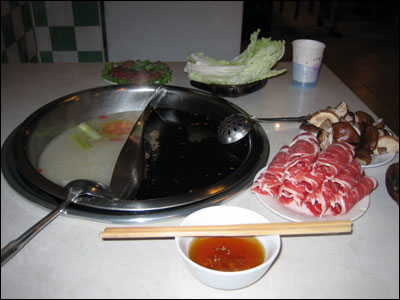
The author eagerly anticipates dishes cooked in a classic Chengdu “hot pot,” a split pot with mild fish broth on the left and spicy oil on the right.
I finally made my way to Chengdu and the hotpot restaurant. Hotpot is a Sichuan specialty, and it’s the one thing visitors shouldn’t miss. There are numerous hotpot restaurants around, easily identifiable by the burner in the middle of the table. I entered hesitantly and ordered mostly by pointing at other people’s tables. The waiter walked me through the process and I waited eagerly for my super-spicy meal. The restaurant was beginning to fill up with large groups of people gathered around their tables, chatting loudly. A large metal pot split down the middle was put on the burner on my table. One side had red oil with lots of red chili peppers and Sichuan peppercorns floating around, the other side had a milder fish broth. The liquids began to boil, and I was brought dishes of sliced meat and vegetables. You cook these by putting the morsels in the oil or broth, snagging them with chopsticks, and dipping them in a sesame-flavored sauce on the table.
The cooking part was actually the most fun. I happily dipped my meat and vegetables in the boiling oil and then put them on a plate to cool before tasting. I ate the first piece of meat and it was numbing, absolutely searing; I could barely taste anything. I tried to clean off the meat by dipping it into the fish broth, but the spice had already been seared into it. Eating the food was actually painful, and my stomach was beginning to feel upset. I decided to cook the rest of the food in the broth side, but the fire from the first few pieces of meat hadn’t yet dissipated. In fact, it felt more intense. I sat in the restaurant for quite some time trying to finish the rest of my meal. I managed to barely finish the vegetables cooked in the broth, and only consumed half of the meat cooked in the oil.
As I left the restaurant feeling a little defeated by the heat of the meal, the waiter gave me a look that I took to mean, “you foreigners can’t handle real spice.” And I agreed with him and felt humble. I came to Sichuan looking for spice, and I certainly found it. But in the end, my seared tongue and aching stomach proclaimed that Sichuan spice is serious business.

A big bowl of steaming hot noodles is a delight on a cold day. After just arriving in Zoiige, the author agrees to lots of spice in the noodles but is anxious to start eating. Indeed, the dish turned out to be too spicy.
Lisa Tae-Ran Schroeder
Dear Reader,
In The Fray is a nonprofit staffed by volunteers. If you liked this piece, could you
please donate $10? If you want to help, you can also:

